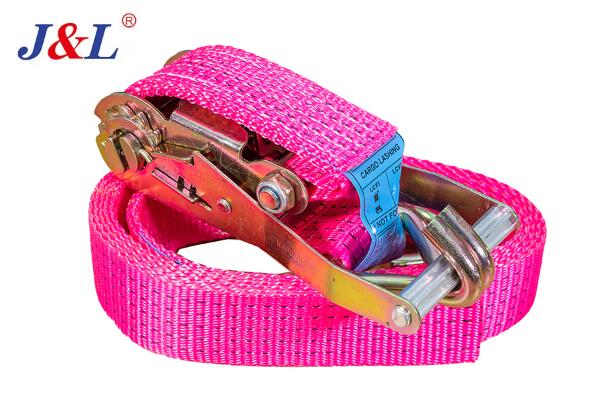Unlocking the Potential of Ratchet Straps: A Practical Guide
Mar. 08, 2024
Ratchet straps, also known as tie-down straps or lashing straps, are indispensable tools for securing cargo during transportation or storage. Their versatility, strength, and ease of use make them essential equipment in various industries, including logistics, construction, and automotive.
Understanding Ratchet Straps: Ratchet straps consist of a webbing material, typically made of polyester or nylon, and a ratcheting mechanism for tightening and securing the strap around cargo. The ratchet mechanism allows for precise tensioning, ensuring a secure and reliable hold on the load. Ratchet straps come in various lengths, widths, and load capacities to accommodate different types of cargo and transportation requirements.
Practical Applications:
Transportation: Ratchet straps are commonly used to secure cargo on trucks, trailers, and flatbeds during transportation. Whether hauling construction materials, equipment, or household goods, ratchet straps provide a safe and efficient means of preventing load shifting, shifting, or damage during transit.
Cargo Management: In warehouses, distribution centers, and storage facilities, ratchet straps are used to organize and secure palletized goods, crates, and containers. By properly securing items to pallets or shelving units, ratchet straps help maximize storage space and minimize the risk of accidents or damage.
Outdoor Recreation: Ratchet straps are popular among outdoor enthusiasts for securing gear and equipment during camping, boating, or off-road adventures. Whether securing kayaks to roof racks or securing tents and tarps to vehicles, ratchet straps offer a convenient and reliable solution for outdoor gear transportation.
Benefits of Ratchet Straps:
Strength and Durability: Ratchet straps are engineered to withstand heavy loads and harsh environmental conditions, making them ideal for demanding applications in various industries.
Versatility: With adjustable lengths and multiple attachment points, ratchet straps can accommodate a wide range of cargo sizes and shapes, offering flexibility and convenience.
Featured content:
How Does Electric vs Manual Hedge Cutter Work?
What Are Shear Shrubbers vs Hedge Trimmers?
Top 7 Garden Hose Reels for Easy Storage
Garden Hose Reels vs. Traditional Storage: Which Wins?
How Cordless Oscillating Multi-Tools Redefine DIY Projects?
Top 5 Cordless Oscillating Multi-Tools: Which One Reigns Supreme?
The Benefits of Using Hedge Shears for Pruning PlantsEase of Use: The ratcheting mechanism allows for quick and precise tensioning, enabling users to tighten the strap securely with minimal effort.
Reusability: Ratchet straps are reusable and can be easily re-tensioned and repositioned for multiple uses, providing long-term value and cost savings.
Best Practices for Usage:
Inspect Straps: Before each use, inspect ratchet straps for signs of wear, damage, or deterioration. Replace any straps that show signs of damage to ensure safe and reliable performance.
Proper Tensioning: Ensure that ratchet straps are tensioned properly to secure the load effectively. Over-tightening can damage the cargo or the strap, while under-tightening may result in load shifting or instability.
Secure Attachment Points: Attach ratchet straps to sturdy anchor points on the vehicle or cargo to prevent slippage or detachment during transit. Avoid attaching straps to sharp edges or corners that may cause abrasion or cutting.
Follow Regulations: Adhere to relevant safety regulations and guidelines when using ratchet straps for commercial or industrial applications, including load restraint standards and weight limits.
Ratchet straps are versatile, durable, and easy-to-use tools for securing cargo in transportation, storage, and outdoor recreational activities. By understanding their features, practical applications, benefits, and best practices for usage, users can unlock the full potential of ratchet straps and ensure safe and reliable cargo management in various industries. Whether hauling goods on the road, organizing inventory in a warehouse, or venturing into the great outdoors, ratchet straps provide a trusted solution for securing valuable assets and preventing damage during transit.
Key Questions to Ask When Choosing Hedge Shears for Your Garden
Post Hole Diggers vs. Augers: Which Tool Reigns Supreme?
Essential Benefits of Using a Rubber Garden Bucket
Garden Hose Reels vs. Manual Reels: Which is Better?
Top Cordless Oscillating Multi-Tool Picks for 2024
Earth Auger vs Manual Post Hole Digger: Which Is Best?
How Can You Master Wood Cutting with a Hand Saw Efficiently?
238
0
0
All Comments (0)
Previous: None
Next: None
If you are interested in sending in a Guest Blogger Submission,welcome to write for us!



Comments